Medieval Gévaudan |
The medieval Gévaudan, roughly corresponding to present-day Lozère, was a territory of mountains and difficult-to-access plateaus, structured by the powerful lineage of the bishops-counts of Mende. The landscape is characterized by the vast expanses of the Causse Méjean and the Aubrac mountains, contrasting with the deep valleys of the Tarn and the schist of the Cévennes. The history and heritage of this era are marked by fortified castles, watchtowers, and massive Romanesque churches, often remodeled, which testify to feudalism and local conflicts. The flora of high altitudes and the fauna of the vast spaces, such as sheep farming and wolves, significantly influenced the lives of isolated communities. It was a land of strong autonomy, whose cultural identity remained very pronounced despite its isolation.
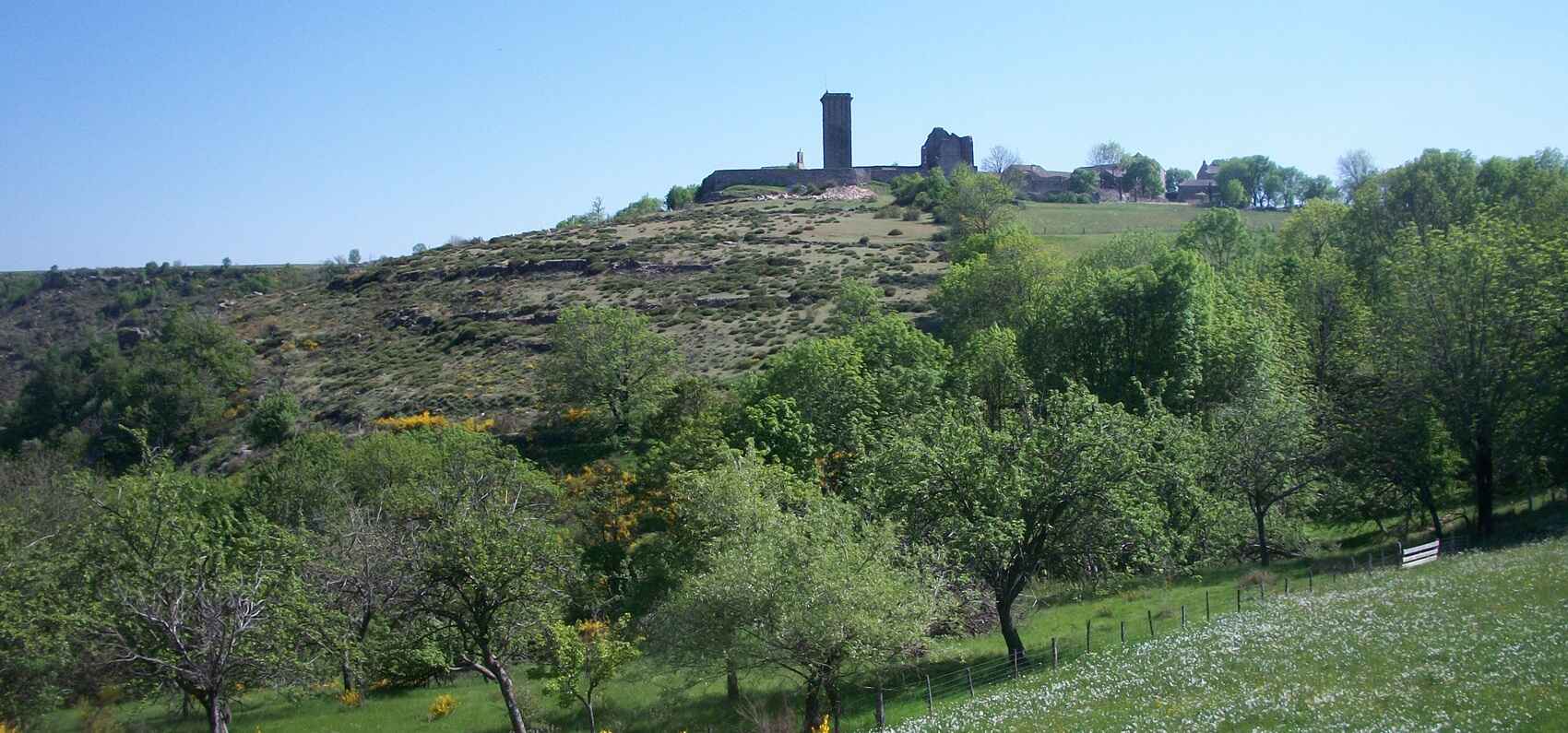
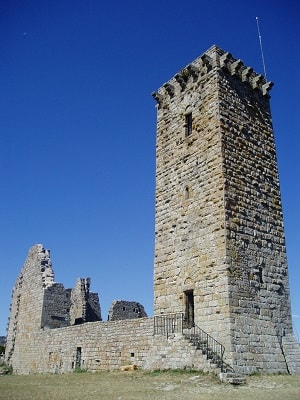 The Gévaudan,
fiercely reconquered from the Arabs by the Carolingian dynasty, soon finds itself torn
between a Frankish authority that is merely theoretical due to its distance
and the principality of Aquitaine, which is somewhat indifferent to this
poor, primarily agricultural and hard-to-access region.
The Gévaudan,
fiercely reconquered from the Arabs by the Carolingian dynasty, soon finds itself torn
between a Frankish authority that is merely theoretical due to its distance
and the principality of Aquitaine, which is somewhat indifferent to this
poor, primarily agricultural and hard-to-access region.
Until the Hundred Years' War, the real authority will actually be held by a few large feudal lordships (the "eight baronies") sufficiently powerful and organized to neglect too narrow allegiances. Only the Church can at this time be considered a "counter-power" that will gradually establish itself as a relay of royal authority (paréage act of 1306).
This royal authority can be considered definitively established by the end of the 15th century. Thus from the 9th to the 15th century, more than half a millennium! The "eight baronies of Gévaudan" govern the land according to the principle of vassalage supported by a dense network of fortresses and castles, symbols of both protection and subjugation, reassuring or terrifying depending on the times, locations... and the character of the holder of the fief.
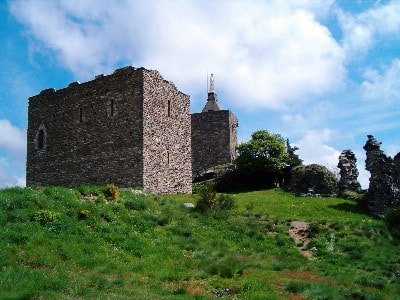 We must mention here Saint Julien du Tournel, St Julien d'Arpaon,
the castle of Portes (in the Gard but owned by the Châteauneuf de Randon), Luc on the
Stevenson Way GR®70 (among other impregnable fortresses) whose only passage of
centuries could eventually prevail...
We must mention here Saint Julien du Tournel, St Julien d'Arpaon,
the castle of Portes (in the Gard but owned by the Châteauneuf de Randon), Luc on the
Stevenson Way GR®70 (among other impregnable fortresses) whose only passage of
centuries could eventually prevail...
Apart from a small lordship, quite dense and present throughout this period in the Southeast of Gévaudan, the feudal grip system is classic and relatively homogeneous. The lord holds in fief (theoretically from the king) a territory that he allocates to lesser lords. They themselves bind warriors and peasants through the distribution of tenures allowing families to subsist in exchange for services or taxes that ensure the maintenance of the castle and its defensive system as well as the economy of its territory.
These strong houses, castles of all kinds, defensive sites, manors or watchtowers, villages enclosed by high walls, are still present, sometimes in a state of grandiose ruins on their seemingly impregnable mound; but also sometimes still alive, maintained, restored by current owners often descended from ancestral lineages...
As you stroll through medieval Gévaudan, you will encounter all imaginable styles:
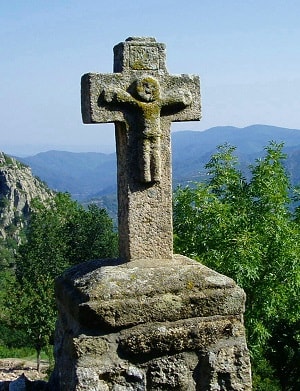 The "classic" model surrounded by
walls with its protruding defensive towers, sometimes preceded by an outer enclosure.
Between the enclosure and the wall, moats. If the drawbridge and the portcullis have
disappeared, the merlons and crenels are often there to protect a walkway that is
better imagined than sought to be traversed. Arrow slits and machicolations continue
to protect the curtains. Finally, the keep (see the castle of Luc, the Tower of the
English at Châteauneuf), the main piece of ultimate defense, which often still
overlooks the dormant remains of these stone vessels, all drenched in mist and with
uncertain outlines.
The "classic" model surrounded by
walls with its protruding defensive towers, sometimes preceded by an outer enclosure.
Between the enclosure and the wall, moats. If the drawbridge and the portcullis have
disappeared, the merlons and crenels are often there to protect a walkway that is
better imagined than sought to be traversed. Arrow slits and machicolations continue
to protect the curtains. Finally, the keep (see the castle of Luc, the Tower of the
English at Châteauneuf), the main piece of ultimate defense, which often still
overlooks the dormant remains of these stone vessels, all drenched in mist and with
uncertain outlines.
The protection of the populations of the fief, but also a symbol of strength and power, a second generation of buildings will see the light of day in Gévaudan between the 15th and 16th centuries. Of medieval appearance, this castle created or modified seeks less to defend than to impress (castle of Roquedols at Meyrueis, of Montesquieu at La Malène, of la Caze at Sainte-Enimie, of Castanet near Villefort on GR®72). A symbol of prestige, it presents an architecture that is still military but where aesthetics already prevails over strategy, in more cheerful sites, less exposed to the elements and the rigors of altitude.
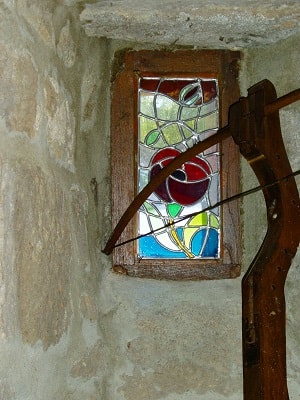 A third generation appears in the
17th and 18th centuries. A lordly residence, it remains imposing, even austere
(castle of la Baume), but the concern for balance and light now gives it a distinctly
more residential appearance (castle of Barre at Langogne, of Ayres at Meyrueis). The
keep has completely disappeared, the defensive system no longer exists or is at
most in a state of memory. It is now the French-style gardens, the wooded parks, and
the large windows that let light and landscaped vegetation into the house. A symbol
of a family’s economic and social success, comfort and decoration take precedence
under the Italianate influences of the "Folies" of Montpellier.
A third generation appears in the
17th and 18th centuries. A lordly residence, it remains imposing, even austere
(castle of la Baume), but the concern for balance and light now gives it a distinctly
more residential appearance (castle of Barre at Langogne, of Ayres at Meyrueis). The
keep has completely disappeared, the defensive system no longer exists or is at
most in a state of memory. It is now the French-style gardens, the wooded parks, and
the large windows that let light and landscaped vegetation into the house. A symbol
of a family’s economic and social success, comfort and decoration take precedence
under the Italianate influences of the "Folies" of Montpellier.
You will encounter the 12th century, the 14th, the 16th, 18th, and 19th centuries. But do not miss the visit to the castle of La Baume. And Marvejols, Chanac and its keep (and its Romanesque church with a very pure style!). There is even a Carolingian calvary on the Causse Méjean (village of Buffre). As for dolmens and menhirs, capped bars and prehistoric enclosures, they dot our region of the Cévennes (Mont-Lozère, Causse de Sauveterre and Causse Méjean). A magnificent Roman mausoleum (near Lanuéjols) and the Gallo-Roman city of Javols (destroyed at the end of the 3rd century) are also worth the detour!
The Gévaudan, fiercely reconquered from the Arabs by the Carolingian dynasty, soon finds itself torn between a Frankish authority that is merely theoretical due to its distance and the principality of Aquitaine, which is somewhat indifferent to this poor, primarily agricultural and hard-to-access region.
Until the Hundred Years' War, the real authority will actually be held by a few large feudal lordships (the "eight baronies") sufficiently powerful and organized to neglect too narrow allegiances. Only the Church can at this time be considered a "counter-power" that will gradually establish itself as a relay of royal authority (paréage act of 1306). This royal authority can be considered definitively established by the end of the 15th century.
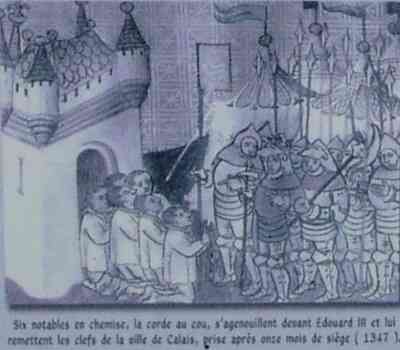 Thus,
from the 9th to the 15th century, more than half a millennium! The "eight baronies of
Gévaudan" govern the land according to the principle of vassalage supported by a
dense network of fortresses and castles, symbols of both protection and
subjugation, reassuring or terrifying depending on the times, locations... and the
character of the holder of the fief. We must mention here Saint Julien du Tournel, St
Julien d'Arpaon, the castle of Portes (in the Gard but owned by the Châteauneuf de
Randon), Luc on the Stevenson Way GR®70 (among other impregnable fortresses) whose only passage of the centuries
could eventually prevail...
Thus,
from the 9th to the 15th century, more than half a millennium! The "eight baronies of
Gévaudan" govern the land according to the principle of vassalage supported by a
dense network of fortresses and castles, symbols of both protection and
subjugation, reassuring or terrifying depending on the times, locations... and the
character of the holder of the fief. We must mention here Saint Julien du Tournel, St
Julien d'Arpaon, the castle of Portes (in the Gard but owned by the Châteauneuf de
Randon), Luc on the Stevenson Way GR®70 (among other impregnable fortresses) whose only passage of the centuries
could eventually prevail...
Apart from a small Aleutian lordship, quite dense and present throughout this period in the Southeast of Gévaudan, the feudal grip system is classic and relatively homogeneous. The lord holds in fief (theoretically from the king) a territory that he allocates to lesser lords. They themselves bind warriors and peasants through the distribution of tenures allowing families to subsist in exchange for services or taxes that ensure the maintenance of the castle and its defensive system as well as the economy of its territory.
These strong houses, castles of all kinds, defensive sites, manors or watchtowers, villages enclosed by high walls, are still present, sometimes in a state of grandiose ruins on their mound seemingly impregnable; but also sometimes still alive, maintained, restored by current owners often descended from ancestral lineages...
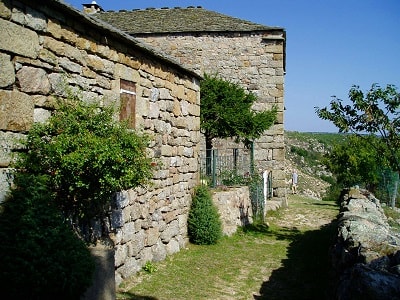 As
you stroll through medieval Gévaudan, you will encounter all
imaginable styles. The "classic" model surrounded by walls with
its protruding defensive towers, sometimes preceded by an outer enclosure.
Between the enclosure and the wall, moats. If the drawbridge and the
portcullis have disappeared, the merlons and crenels are often there to protect a
walkway that is better imagined than sought to be traversed.
Arrow slits and machicolations (see in particular the restored wooden platforms of
the castle of Saint-Germain-de-Calberte) continue to protect the curtains. The keep, finally
(see the castle of Luc, the Tower of the English at Châteauneuf de Randon), the main piece
of ultimate defense, which often still overlooks the dormant remains of
these stone vessels, all drenched in mist and with
uncertain outlines.
As
you stroll through medieval Gévaudan, you will encounter all
imaginable styles. The "classic" model surrounded by walls with
its protruding defensive towers, sometimes preceded by an outer enclosure.
Between the enclosure and the wall, moats. If the drawbridge and the
portcullis have disappeared, the merlons and crenels are often there to protect a
walkway that is better imagined than sought to be traversed.
Arrow slits and machicolations (see in particular the restored wooden platforms of
the castle of Saint-Germain-de-Calberte) continue to protect the curtains. The keep, finally
(see the castle of Luc, the Tower of the English at Châteauneuf de Randon), the main piece
of ultimate defense, which often still overlooks the dormant remains of
these stone vessels, all drenched in mist and with
uncertain outlines.
The protection of the populations of the fief, but also a symbol of strength and power, a second generation of buildings will see the light of day in Gévaudan between the 15th and the 16th century. Of medieval appearance, this castle created or modified seeks less to defend than to impress (castle of Roquedols at Meyrueis, of Montesquieu at La Malène, of la Caze at Sainte-Enimie, of Castanet near Villefort on GR®72). A symbol of prestige, it presents an architecture that is still military but where aesthetics already prevails over strategy, in more cheerful sites, less exposed to the elements and the rigors of altitude.
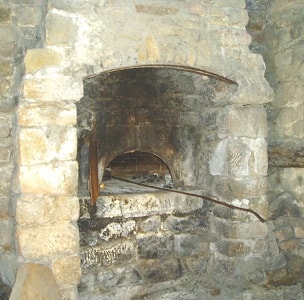 A
third generation appears in the 17th and 18th centuries. A lordly residence,
it remains imposing, even austere (castle of la Baume), but the concern for
balance and light now gives it a distinctly more residential appearance (castle of
Barre at Langogne, of Ayres
at Meyrueis). The keep has completely disappeared, the defensive system no longer exists or is at
most in a state of memory. It is now the French-style gardens, the wooded parks, and
the large windows that let light and landscaped vegetation into the house. A symbol
of a family’s economic and social success, comfort and decoration take precedence
under the Italianate influences of the "Folies" of Montpellier.
A
third generation appears in the 17th and 18th centuries. A lordly residence,
it remains imposing, even austere (castle of la Baume), but the concern for
balance and light now gives it a distinctly more residential appearance (castle of
Barre at Langogne, of Ayres
at Meyrueis). The keep has completely disappeared, the defensive system no longer exists or is at
most in a state of memory. It is now the French-style gardens, the wooded parks, and
the large windows that let light and landscaped vegetation into the house. A symbol
of a family’s economic and social success, comfort and decoration take precedence
under the Italianate influences of the "Folies" of Montpellier.
The last generation, that of a 19th-century once again infatuated with Gothic art, embarks on the decorative castle where a somewhat "cardboard" aesthetic delights in architectural facades, fortunately tempered in Gévaudan by a good sense of " well from our home" and a concrete concern for habitability (see the castle of Orfeuillette near La Garde or the castle of la Chastre in Saint-Alban on Limagnole, near the fortress of the same name currently undergoing restoration).
Colors of the stones, corbels, corner towers, and mullions adorn façades that are sometimes much older, remodeled, flattering the narcissism of "arrived" families returning to their homeland but refusing to upset the interior layout and comfort of life that the climatic rigors of our region now render quite imperative.
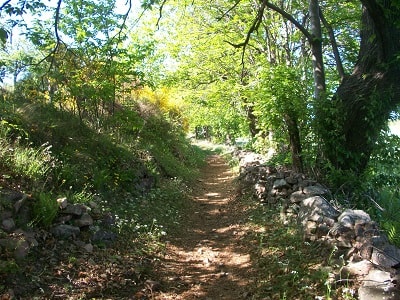 Everything is language.
Let's listen to that of the castles in the beautiful land of Gévaudan. It tells
and tells again, never tiring, the story of each valley and its high plateaus,
the routes of transhumance and pilgrimage. The story of the reconquest from the
Visigoths, the Saracens, and finally the English. Protections? Harassments?
Both, of course, depending on the times and local conflicts. Thus, the knight
peers of La Garde-Guérin, alternately pillagers and then defenders of the GR®700
Voie Régordane. Knights, bandits, and then vassals of the bishop count of Mende
for the protection of merchants and pilgrims.
Everything is language.
Let's listen to that of the castles in the beautiful land of Gévaudan. It tells
and tells again, never tiring, the story of each valley and its high plateaus,
the routes of transhumance and pilgrimage. The story of the reconquest from the
Visigoths, the Saracens, and finally the English. Protections? Harassments?
Both, of course, depending on the times and local conflicts. Thus, the knight
peers of La Garde-Guérin, alternately pillagers and then defenders of the GR®700
Voie Régordane. Knights, bandits, and then vassals of the bishop count of Mende
for the protection of merchants and pilgrims.
One of the prettiest fortified villages in France where the tradition of hospitality and protection of travelers has lasted for a thousand years, still currently sheltered by its walls and strong houses. Thus, the Tower of the English at Châteauneuf-de-Randon where Du Guesclin perished, who, post-mortem, achieved his ultimate success here. "Death, where is your victory?" - "At Châteauneuf in Gévaudan, if you please..." ... and the Tower of Apcher, last vestige of this powerful barony, which witnessed the victory of simple peasants over more seasoned pillaging soldier troops... Castelbouc with its sulfurous legend, Aubrac and its knight-servants. Lozère, through its castles, never ceases to evoke its warrior bravery and recount its great deeds of arms. Its epic poems are engraved in its stones as in its heart. Forever.
Who has not thought one day to walk "in the footsteps of the Beast" in the land of Gévaudan? The possibilities are numerous: four loops of the "Tours de Margeride" will allow you to explore this gently mountainous massif. The Aumont-Aubrac loop: discovery of the land of the Gabales, excavations, and the archaeological museum of Javols. The route rises to the Truc de Fortunio and overlooks the magnificent lake of Charpal. In its northern course, the GR®43 borders the bisons of Margeride (Sainte Eulalie). The Grandrieu loop: the path takes the draille of Margeride on the crests of the massif. Return via Châteauneuf de Randon, fief of the valiant Du Guesclin. The Langogne loop: Itinerary starting from Langogne and Lake Naussac. It rises to Grandrieu and the summits of Randon. After Belvezet, the landscapes change in the high valley of Lot and the foothills of the Cévennes (Prévenchères, La Bastide-Puylaurent). The Malzieu ville loop: The shortest of the Margeride loops, it starts in Malzieu ville, a perfectly restored traditional medieval town. A path marked by the history of the Resistance. From Mende, with its superb Gothic cathedral, an access ramp offers the possibility to join the "Tours en Margeride".
The Bishops of Gévaudan
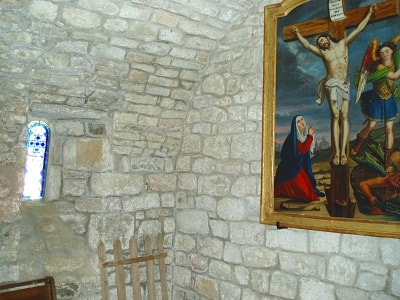 The first bishop elected by the Gabales Christians was, following vague indications,
the disciple of St. Martial of Limoges, St. Severin. He must have been skillful enough
to reconcile the union of the church with an administration still in effect and, despite
Roman despotism, to erect buildings, oratories, and crosses.
The first bishop elected by the Gabales Christians was, following vague indications,
the disciple of St. Martial of Limoges, St. Severin. He must have been skillful enough
to reconcile the union of the church with an administration still in effect and, despite
Roman despotism, to erect buildings, oratories, and crosses.
His successors, named Saint-Firmin (314) and Génialis, cited as "deacon of the city of Gévaudan at the council of Arles," sat at Anderitum (Javols).
During the Vandal invasion of 408, the castrum of Grèzes withstood while Javols was taken and razed. Its bishop, St. Privat, fled to Mount Mimat, pursued by Crocus, the barbarian chief, who killed him for refusing to intervene to obtain the surrender of Grèzes. Others say: "in the face of the refusal of the castrum to surrender".
His body was buried, it is said, on the site of the cathedral of Mende. The miracles multiplying there attracted faithful and inhabitants of Javols, Mimate (Mende) was founded around the tomb.
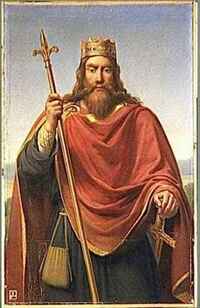 The Visigoths after the Vandals devastated Gévaudan. Eric, their chief, appointed
Victor as governor who drove out the bishops. They did not return until his death. In
484, we find, in Gévaudan, Valère, who stands out for an homage of loyalty to Pope St.
Leon. Then, in 506, Léontinus delegates his deacon Optimus to the council of Agde.
The Visigoths after the Vandals devastated Gévaudan. Eric, their chief, appointed
Victor as governor who drove out the bishops. They did not return until his death. In
484, we find, in Gévaudan, Valère, who stands out for an homage of loyalty to Pope St.
Leon. Then, in 506, Léontinus delegates his deacon Optimus to the council of Agde.
Clovis's victory in 507 over the Visigoths annexed Gévaudan to Austrasia, and St. Hilaire, commonly called Chéli, settled in Javols, which was reborn from its ashes. St. Eventhe, who succeeded him, remained in Javols and attended the council of Orléans, preceding the irascible quarrel of Palladius and St. Gregory of Tours who wanted to absorb the government of Gévaudan. Their violent disputes continued and led to the assassination of Innocentius. St. Louvent was subsequently enthroned. But he was assassinated in turn and Agricole, fleeing Javols, returned to Mende in 625. He attended the council of Reims before yielding to St. Ibère who, in 630, blessed, as a saint, the abbess of the monastery of Ste-Enimie, the sister of King Dagobert, so the legend goes.
In 688, Gévaudan returned to Aquitaine. Mende and Javols disputed the episcopate when the Sarrazine invasion emerged, and it would take waiting for its crushing at Moissac by Charles Martel to see St. Frézal reappear in Mende, this time, who was assassinated there. Despite this crime, Agenufle maintained himself there as did his successor, William I, who modestly titled himself "bishop of Mende," while Stephen I, who would come after, would take the title of bishop of Gévaudan.
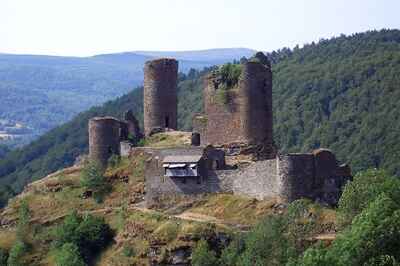 In 998, great rejoicing for Langogne, Bishop Mantfred lays the first stone of
his church.
In 998, great rejoicing for Langogne, Bishop Mantfred lays the first stone of
his church.
In 1052, Aldebert de Peyre founded the monastery of Chirac, and in 1095, William II consecrated the church of St. Flour. Subsequently, Robert, abandoning the mitre of abbot of Chanteuges, took the seat of Mende ahead of Aldebert de Peyre II who had the honor of starting the construction of his cathedral and laying the first stone, but died the same year and made way for William III.
Relentlessly, the bishops envied the temporal power of Gévaudan. Aldebert III of Tournel managed to seize this advantage in 1151. He went to Paris, swore loyalty to King Louis VII, who, accepting the homage, delivered the famous charter of the "Golden Bull," sealed by the monarch. It was equivalent to the attribution and qualification of count of Gévaudan, usurping a title held by the county of Grèzes. This spoliation attracted violent reprisals, and the bishop, despite his precaution of surrounding the town of Mende with walls, was attacked by his own brother and the local nobility who arrested him, threw him into prison at his castle of Capieu, where he died.
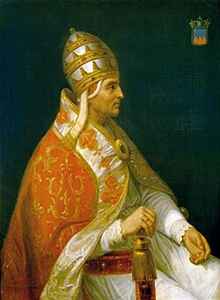 In 1112, Gévaudan came under the domination of the King of Aragon, but homage was only to be paid in 1204. In the meantime, Guillaume IV de Peyre, Étienne II, and Odilon de Mercœur were disputing the episcopate; Étienne II, sacristan of Brioude, "a man of merit but whose birth was tainted" was elected by the cathedral chapter. He was enthroned in place of Guillaume IV, having been unable to secure the see of Chartres, where he had been appointed by the Bishop of Bourges. Odilon de Mercœur, although designated by Rome, had to wait for the vacancy of the episcopate. Moreover, the incumbent prelate became very popular by stopping the devastation of the crops of peasant lands on which soldiers and nobles claimed hunting rights and also for the reprisals exercised against the Baron of Randon, whom he had subdued and burned 18 of his castles.
In 1112, Gévaudan came under the domination of the King of Aragon, but homage was only to be paid in 1204. In the meantime, Guillaume IV de Peyre, Étienne II, and Odilon de Mercœur were disputing the episcopate; Étienne II, sacristan of Brioude, "a man of merit but whose birth was tainted" was elected by the cathedral chapter. He was enthroned in place of Guillaume IV, having been unable to secure the see of Chartres, where he had been appointed by the Bishop of Bourges. Odilon de Mercœur, although designated by Rome, had to wait for the vacancy of the episcopate. Moreover, the incumbent prelate became very popular by stopping the devastation of the crops of peasant lands on which soldiers and nobles claimed hunting rights and also for the reprisals exercised against the Baron of Randon, whom he had subdued and burned 18 of his castles.
Once in possession of the episcopate, Odilon de Mercœur showed equal firmness by forcing E. de Tournel to return to him the castle of Capieu and putting to flight de Randon who was attempting to besiege Mende.
Étienne III, who arrived in 1277, attended the council of Orléans, before making way for Julien, who remained at the same time Cardinal of St. Peter's of the Chains, so that he did not delay in handing his crozier to Guillaume IV Durant, author of the paréage act with King Philip the Fair, an act that would only be realized by his successor and nephew Guillaume V Durant, in 1296.
Jean-des-Arcis would only make a brief stop in Mende in 1331; he was appointed to Amiens and left his suite to Aldebert de Loadet, then to Pierre I d'Aigrefeuille in 1357, and to Guillaume VII.
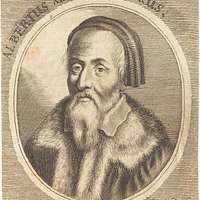 In 1361, Pierre II Gérard de la Rovère, nephew of Pope Urban V, bishop of Uzès, transferred to Mende, was called to Avignon, leaving the diocese to his vicars, without a holder until 1371, when Guillaume VI de Chanac took office, leaving his succession to Bompar Virgile, who soon passed to Uzès, making way for Pons de la Garde. He had the honor of presiding over the Estates General in 1379, which launched a call to the king to chase away the English.
In 1361, Pierre II Gérard de la Rovère, nephew of Pope Urban V, bishop of Uzès, transferred to Mende, was called to Avignon, leaving the diocese to his vicars, without a holder until 1371, when Guillaume VI de Chanac took office, leaving his succession to Bompar Virgile, who soon passed to Uzès, making way for Pons de la Garde. He had the honor of presiding over the Estates General in 1379, which launched a call to the king to chase away the English.
And the rapid succession of bishops continues. Jacques II d'Armagnac, in 1387, d'Auch Robert de Base, in 1390, Guillaume IX de Bois, in 1409, Pierre de Saluées, Géraud du Puy, in 1412, Jean III de Cordie, Rammufle de Peyrussi, Aldebert VI de Peyre de Marchastel, Gui de la Panouse, and finally Antoine de la Panouse, in 1467.
At this time, the bishops had disputes with secular powers. The lieutenant of the Seneschal of Beaucaire, Lanalet, urged the Mendois to establish a Consulate. He even granted a letter patent, conferring on the city Consulate and autonomy, but Pierre IV Riario, nephew of Pope Sixtus IV, as well as his successor Jean IV Petit Dé, opposing the prerogatives of the county of Gévaudan, had their rights restored in 1475. Julien II de la Rovère, another nephew of the aforementioned pope, and Clément de la Rovère, nephew of the latter bishop, as well as François de la Rovère, his brother, and finally Guillaume Duprat, brother of the Chancellor of France, fought for the same cause and won, so that Mende did not have a Consul.
In 1504, the plague decimated Gévaudan, and after the death of Jean de la Rochefoucauld, Charles I de Pisseteu, called to succeed him, resigned in 1538 for fear of contagion.
Nicolas d'Anger, braver, took his place and continually intervened with the king, "to have him destroy the Huguenot fortresses." Renard de Beaume, Adam de Heurtelou, Charles Rousseau, Marshal of France, Daniel de la Mothe Duplessis-Haudancourt, followed the same impulse.
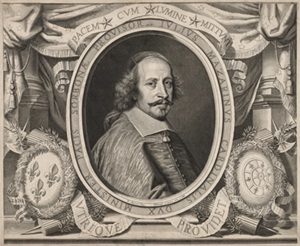 Although he did not achieve his ends, this last prelate at least had the merit of improving the cathedral of Mende and took a great interest in Langogne due to incessant quarrels of interest that arose between his clergy and the Benedictine monastery. He granted a special indulgence to the venerated Virgin in this city and prepared the project that was to be realized by his successor, Sylvestre de Cussy de Marcillac, to lay the first stone of the Capuchin monastery founded in Langogne.
Although he did not achieve his ends, this last prelate at least had the merit of improving the cathedral of Mende and took a great interest in Langogne due to incessant quarrels of interest that arose between his clergy and the Benedictine monastery. He granted a special indulgence to the venerated Virgin in this city and prepared the project that was to be realized by his successor, Sylvestre de Cussy de Marcillac, to lay the first stone of the Capuchin monastery founded in Langogne.
Hyacinthe Serroni, who came from Rome following Mazarin, took possession of the episcopate of Mende, immediately after having pronounced the funeral oration for Anne of Austria, wife of the said Cardinal Mazarin. But this Italian prelate became bored in Gévaudan, so after having restored his heavily burdened finances, he stealthily took the road to Paris, where he died, in fact, as soon as he arrived. The position was taken over by François de Baudri de Piancourt, who marked his stay with beautiful tapestries given to the cathedral, grilles installed at the castle of Chanac, a chapel built at the Hospital, and a beautiful alley of poplars that contributed to the embellishment of the avenue towards Chaldecoste.
Pierre V Baglion de la Salle de Saillant became bishop in 1677, and Gabriel Florent de Choiseul Beaupré in 1723, preceding Tean-Armand de Castellane, who closed the door of the episcopate at the time of the Revolution of 1789. Before his departure from Mende, he urged his clergy not to take an oath to the Constitution. He left for Versailles and was to be killed in a riot at the Orangerie. Nogaret succeeded him and became the first bishop to have taken an oath to the Constitution.
The astonishment arises from the rapid succession of bishops at the episcopal seat of Mende, with this parade of great names from the armorial of France, passing without interruption in a deprived country and a small episcopate so unattractive. Their eagerness to take this position can be explained by the quality of "Count of Gévaudan" attached to it, which made it one of the richest sees in France, providing enormous prebends to the holders. High personalities, with tarnished coats of arms and flattened purses, vied for the tedious and distant prelature where they made only a brief visit, quickly grabbing the loot to depart for more cheerful horizons.
Former holiday hotel with a garden along the Allier, L'Etoile Guest House is located in La Bastide-Puylaurent between Lozere, Ardeche, and the Cevennes in the mountains of Southern France. At the crossroads of GR®7, GR®70 Stevenson Path, GR®72, GR®700 Regordane Way, GR®470 Allier River springs and gorges, GRP® Cevenol, Ardechoise Mountains, Margeride. Numerous loop trails for hiking and one-day biking excursions. Ideal for a relaxing and hiking getaway.
Copyright©etoile.fr